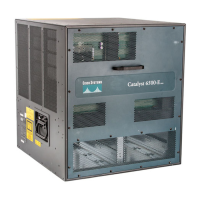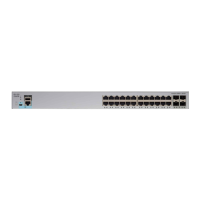23-20
Catalyst 6500 Series Switch Software Configuration Guide—Release 8.7
OL-8978-04
Chapter 23 Configuring Redundancy
Configuring Redundant Supervisor Engines on the Switch
• The expected results are as follows:
–
The active supervisor engine f1 image is not copied to the standby supervisor engine.
–
The standby supervisor engine bootstring is modified to the following:
bootflash:f2,1;bootflash:f1,1;.
–
The standby supervisor engine is not reset.
Example 4: File copied, oldest file deleted, bootflash squeezed, bootstring modified, standby supervisor engine not reset
The configuration for this example is as follows:
• The active supervisor engine configuration is as follows:
–
Run-time image: bootflash:f1
–
Bootstring: bootflash:f1,1;
–
Bootflash: f1,f2
• The standby supervisor engine configuration is as follows:
–
Run-time image: bootflash:f1
–
Bootstring: bootflash:f1,1;
–
Bootflash: f0,f1,f3 (less than 1 MB left on device)
• The time stamp for f1 on the active supervisor engine is the same as f1 on the standby supervisor
engine. The time stamp for f0 is older than f1, and the time stamp for f1 is older than f3.
• The active supervisor engine bootstring is modified to the following: bootflash:f2,1;bootflash:f1,1;
• The expected results are as follows:
–
The active supervisor engine attempts to copy its f2 image to the standby supervisor engine.
–
Because there is not enough space available on the standby supervisor engine bootflash, the
redundant synchronization function finds the oldest file (f0), deletes it, and squeezes bootflash.
–
The active supervisor engine copies its f2 image to the standby supervisor engine and renames
it BTSYNC_f2.
–
The standby supervisor engine bootflash is modified to the following: f1, f3, BTSYNC_f2.
–
The standby supervisor engine bootstring is modified to the following:
bootflash:BTSYNC_f2,1;bootflash:f1,1;.

